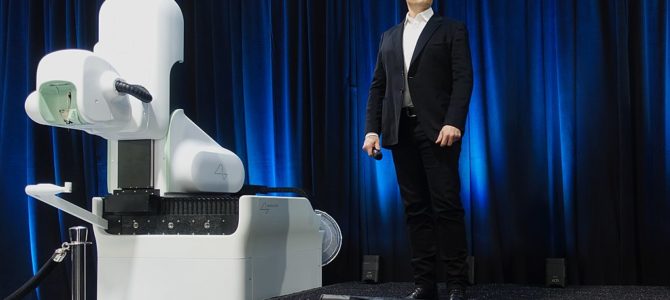
Last year, Elon Musk predicted his Neuralink brain implant could eventually allow people to bypass human language. With a handful of AI-powered chips jabbed into their brains, Neuralink users could converse with their thoughts alone. Poetry and liturgy would become a sentimental pastime, like roasting marshmallows over a campfire.
“In principle, you would be able to communicate very quickly, and with far more precision, ideas,” Musk mumbled to Joe Rogan. “And language would — I’m not sure what would happen to language … [But] really, in the first few versions all we’re going to be trying to do is solve brain injuries.”
Many scoffed at the time, just as they did when Musk hyped the idea of a self-driving Tesla. Today, a quick glance around the 405 freeway in Los Angeles provides evidence that a billionaire’s dreams can quickly become the public’s reality — even if a few models have to burst into flames to get there.
On July 14, the transhumanist goal of neuro-telepathy came a step closer to realization, thanks to a major breakthrough by a team at the University of California, San Francisco. Neuroscientists surgically implanted a subdural electrode array on the surface of a stroke victim’s brain. For 81 weeks, they fed his sensorimotor cortex signals into an artificial intelligence system. Using the algorithms’ predictive power as a sort of auto-complete feature, the team was able to translate the subject’s attempts at speech into text with extraordinary accuracy.
Although presently limited to a 50-word vocabulary, the silent patient is able to string together full sentences, which are displayed onscreen in real time. A few evocative examples include: “Here is my computer,” “My family is very comfortable,” “They have faith,” and “Faith is good.”
This experiment was supported by Project Steno, a long-term program funded and supported by Facebook. One of the project’s broader goals was to create a non-invasive helmet that could translate the average user’s thoughts into digital information. Although Facebook Reality Labs decided to put this mass-market brain-cap on hold for now, the engineers are celebrating the UCSF neuroprosthetic implant as a new “milestone” in brain-computer interface.
The experiment’s leader, neuroscientist Edward Chang, extended his gratitude to the social media company. “We’ve learned so much about how speech is processed in the brain [over the past decade], but it’s only in the last five years that advances in machine learning have allowed us to get to this key milestone,” he said. “Facebook’s machine learning advice and funding really accelerated our progress.”
Chang’s results were published in the New England Journal of Medicine. The scientists and engineers over at Neuralink are either seething with envy or dying to announce their next breakthrough in the race to create a cyborg elite.
From Healing To Enhancement
Whether or not Chang’s invasive procedure can be reproduced consistently, the momentum behind it is irrefutable. According to the prevailing mythos in Silicon Valley and various academic programs, technology can ultimately heal what ails us. Brain implants will cure stroke damage, paralysis, traumatic injuries, and even soothe emotional maladies such as depression. Far beyond medical treatment, though, advocates for full augmentation intend to overcome the human condition itself.
Of all the transhumanists in high places, Elon Musk is perhaps the most famous. Last April, he stunned the unsuspecting world with a video of a macaque monkey playing MindPong using two Neuralink chips drilled into his brain. While Neuralink’s next planned step will be treating degenerative brain disease in humans, Musk has said many times his ultimate goal is cognitive enhancement and human-AI symbiosis.
The tycoon’s urgency stems from a belief that artificial intelligence will soon outstrip flawed human cognition, as we’ve already seen with “Go” champions, cancer and heart disease diagnosis, Amazon warehouse management, and aerial dogfight simulations.
“Over time I think we will probably see a closer merger of biological intelligence and digital intelligence,” Musk told a crowd in Dubai. “It’s mostly about the bandwidth, the speed of the connection between your brain and the digital version of yourself.” He’d better get moving, because there’s plenty of competition.
Blackrock Neurotech has arguably made the most progress on neuroprosthesis, at least in terms of medical applications. The company provided a key component for the UCSF breakthrough. “Thirty people worldwide have had an implanted brain-computer interface,” their website boasts. “Twenty-eight of those use Blackrock’s technology.”
“With the longest chronic implant being over six years, we know we can make BCI work for millions – today!” the site homepage says. “And tomorrow we can aim to make hundreds of millions of people walk, talk, see, hear, and feel again.”
Beyond medicine, Kernel is among the most audacious players using a brain-computer interface solely for cognitive enhancement. Currently, the company has developed two non-invasive skullcaps that monitor neurological activity to optimize human performance. Kernel Flow uses near-infrared spectroscopy to measure blood flow. Kernel Flux uses magnetometers to track the brain’s electromagnetic fluctuations.
These helmets can have numerous biofeedback applications, including cognitive and athletic performance, heightened focus during meditation, and brain-to-brain synchrony. Two weeks ago, the company announced its partnership with Statespace to produce superhuman video gamers.
By 2030, Kernel’s founder Bryan Johnson aims to put a brain helmet in every American household. Like Musk, he’s convinced mere humanity will need a wide range of enhancement tools to remain relevant in the age of artificial intelligence — because anything you can do, AI can do better.
The Quest To Accelerate Human Evolution
As a religious philosophy, transhumanism sees technological augmentation as a moral duty. It begins with the quest to overcome disease, old age, and death, and it ends with something like the Christian vision of human perfection and immortality.
It’s an underappreciated fact that many transhumanists are not atheists. Some see technology as a way to realize God’s unfolding plan — even if that means irreversibly altering the human form, or replacing humans with simulacra altogether.
Resting on the pillars of gene-editing, bionic modification, neuro-enhancement, robotics, and artificial intelligence, transhumanism is yet another dream for a better world. Naturally, these far-reaching ambitions invite revulsion and ridicule from normal people.
Perhaps more importantly, human perfection has always proven to be an impossible dream (the Kardashians are a fine example). That limitation may not matter, though, as long as powerful people are driven to pursue grand visions and intend to drag the rest of us along.
Chang’s UCSF brain implant experiment shows that some aspects of the transhumanist vision are already within reach. Technology confers miraculous powers. Even if the subject’s immune system eventually rejects the electrodes in his head (as is quite common), for now he’s able to do something that for nearly two decades was impossible: directly express his thoughts in words.
One of the more touching phrases he’s able to convey is, “I need you.” Although the study makes no mention of it, I imagine he immediately said, “Thank you.” Progress won’t stop with this heart-warming scenario, though. It never does.
The first computers were developed out of military necessity. Today, more than six billion people in the world casually use smartphones to enhance memory and cognition as if they always existed. Sex-change operations were pioneered to cater to troubled souls who saw no other option. Now hormone therapy is in vogue and even children are being convinced to try it.
It’s only a matter of time before we see attempts to use elective brain implants to create elite mathematicians and super-soldiers. Over and over again, we’re told this new world is “inevitable.” That may be the case, but not because God or nature deemed it so. Transhumanism is inevitable for the same reason that war is always imminent: because someone with enough power wants it to happen.









